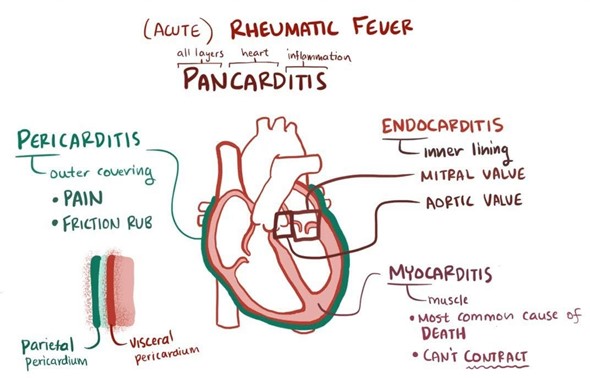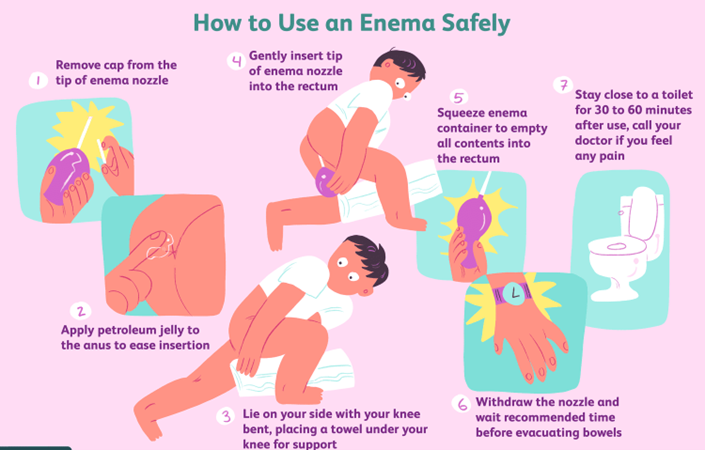A nurse is caring for an 8-year-old child who has acute rheumatic fever. Which of the following assessments is the nurse's priority immediately after admission?
Using a pain-rating tool to determine the severity of the joint pain
Assessing the client's erythematous rash
Identifying the degree of parental anxiety related to the diagnosis
Auscultating the rate and regularity of the child's heart sounds and notifying the provider immediately of abnormalities
The Correct Answer is D
Choice A: Using a pain-rating tool to determine the severity of the joint pain is not the priority assessment for an 8-year-old child who has acute rheumatic fever, which is an inflammatory condition that can affect various organs, especially the heart, joints, skin, and brain. Joint pain is one of the major criteria for diagnosing acute rheumatic fever and can affect one or more large joints, such as knees, ankles, elbows, or wrists. Joint pain can be managed with analgesics or anti-inflammatory drugs.
Choice B: Assessing the client's erythematous rash is not the priority assessment for an 8-year-old child who has acute rheumatic fever, which is an inflammatory condition that can affect various organs, especially the heart, joints, skin, and brain. The erythematous rash is one of the minor criteria for diagnosing acute rheumatic fever and can appear as pink or red patches on the trunk or limbs. The erythematous rash can fade or change location over time and does not require any specific treatment.
Choice C: Identifying the degree of parental anxiety related to the diagnosis is not the priority assessment for an 8-year-old child who has acute rheumatic fever, which is an inflammatory condition that can affect various organs, especially the heart, joints, skin, and brain. Parental anxiety related to the diagnosis can affect their coping skills and ability to care for their child. Parental anxiety can be addressed by providing education, support, and referral to appropriate resources.
Choice D: Auscultating the rate and regularity of the child's heart sounds and notifying the provider immediately of abnormalities is the priority assessment for an 8-year-old child who has acute rheumatic fever, as it can indicate cardiac involvement, which is the most serious complication of acute rheumatic fever. Cardiac involvement can cause damage to the heart valves, myocardium, or pericardium and lead to heart failure or death. Abnormalities in heart sounds may include murmurs, rubs, gallops, or arrhythmias.

Nursing Test Bank
Naxlex Comprehensive Predictor Exams
Related Questions
Correct Answer is D
Explanation
Choice A: Polyuria is not a finding of nephrotic syndrome, but rather a finding of diabetes mellitus or diabetes insipidus. Polyuria means excessive urination, which can cause dehydration and electrolyte imbalance.
Choice B: Smoky brown urine is not a finding of nephrotic syndrome, but rather a finding of acute glomerulonephritis or hemolytic uremic syndrome. Smoky brown urine means that there is blood in the urine, which can indicate damage to the glomeruli, the filtering units of the kidneys.
Choice C: Hypertension is not a finding of nephrotic syndrome, but rather a finding of chronic kidney disease or renal artery stenosis. Hypertension means high blood pressure, which can cause damage to the blood vessels and organs.
Choice D: Facial edema is a common finding of nephrotic syndrome, as nephrotic syndrome is a condition in which the kidneys leak large amounts of protein into the urine, causing low blood protein levels and fluid retention. Facial edema means swelling of the face, especially around the eyes, which can occur due to gravity and fluid shifts.
Correct Answer is D
Explanation
Choice A: This prescription does not need clarification, as medicating the client for pain every 4 hours as needed is appropriate for a child who has suspected appendicitis. Appendicitis is a condition that causes inflammation and infection of the appendix, which is a small pouch attached to the large intestine. Appendicitis can cause severe abdominal pain, nausea, vomiting, fever, or loss of appetite. Pain medication can help relieve the discomfort and reduce inflammation.
Choice B: This prescription does not need clarification, as maintaining NPO status is appropriate for a child who has suspected appendicitis. NPO status means nothing by mouth, which means no food or fluids are given to the client. NPO status can prevent further irritation of the appendix and prepare the client for possible surgery.
Choice C: This prescription does not need clarification, as monitoring oral temperature every 4 hours is appropriate for a child who has suspected appendicitis. Oral temperature is a measure of body temperature taken by placing a thermometer under the tongue. Oral temperature can indicate infection or inflammation in the body. Monitoring oral temperature every 4 hours can help detect changes in the client's condition and guide treatment.
Choice D: This prescription needs clarification, as administering an enema is not appropriate for a child who has suspected appendicitis. An enema is a procedure that involves inserting a tube into the rectum and injecting fluid into the colon to stimulate bowel movement. An enema can cause perforation or rupture of the appendix, which can lead to peritonitis, which is inflammation of the peritoneum, which is the membrane that lines the abdominal cavity. An enema can also increase the risk of bleeding or infection.

Whether you are a student looking to ace your exams or a practicing nurse seeking to enhance your expertise , our nursing education contents will empower you with the confidence and competence to make a difference in the lives of patients and become a respected leader in the healthcare field.
Visit Naxlex, invest in your future and unlock endless possibilities with our unparalleled nursing education contents today
Report Wrong Answer on the Current Question
Do you disagree with the answer? If yes, what is your expected answer? Explain.
Kindly be descriptive with the issue you are facing.
